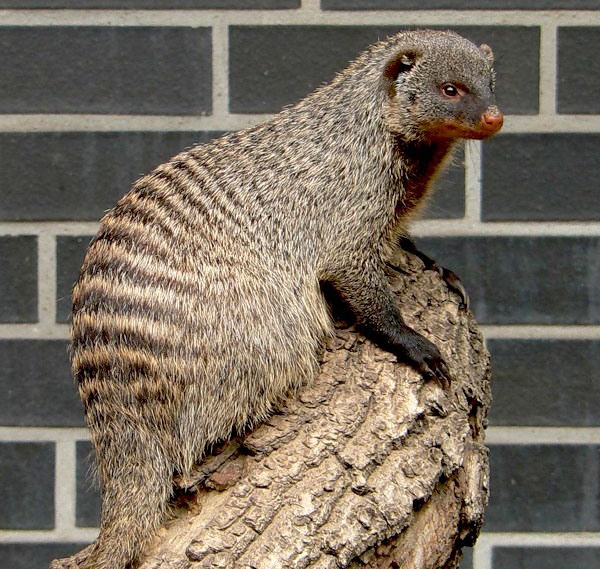
Banded mongoose (Mungos mungo)
Phylum —chordata
Class — mammalia
Order — carnivora
Family — herpestidae
Genus –mungos
Appearance
The Banded mongoose is a sturdy mongoose with a large head, small ears, short, muscular limbs and a long tail, almost as long as the rest of the body. Animals of wetter areas are larger and darker colored than animals of dryer regions. The abdominal part of the body is higher and rounder than the breast area. The rough fur is grayish brown and black, and there are several dark brown to black horizontal bars across the back. The limbs and snout are darker, while the underparts are lighter than the rest of the body. Banded mongooses have long strong claws that allow them to dig in the soil. The nose color of Banded mongoose varies from gray-brown to orange-red.
An adult animal can reach a length of 30 to 45 cm and a weight of 1.5 to 2.25 kg. The tail is 15 to 30 cm long.
Habitat
The Banded mongoose lives in sub-Saharan Africa as far north as Somalia and Sudan. Although it does occur in Gambia and Senegal, it is generally considered as rare in West Africa.
Behavior
The Banded mongoose is gregarious and diurnal, living in packs with 10 to 20 members. Packs usually remain together in a group in the same area, but forage individually. They may hunt together to kill larger prey, such as sand snakes. Their home range can measure 0.8 to 4 sq km, and they prefer to use an old termite mound as a den. A pack’s social organization seems to be matriarchal. Packs care for their young and also look after invalids and elderly, for example, by warning them about danger, grooming them, and giving them access to food. These animals are somewhat nomadic and will not inhabit one particular sheltering area or den for long, usually no more than several days or weeks. At a preferred location they may remain a little longer, and often will return to a favorite shelter site or den to re-use it repeatedly.
Diet
The Banded mongoose seems to be mainly insectivorous, feeding mostly on invertebrates, including centipedes, insects, lizards, snakes and frogs. They also eat fruit, roots, eggs and small rodents.
Reproduction
Banded mongooses are polygynous. Several dominant males will typically mate with and guard the receptive females. These females have been observed, nonetheless, to escape their 'guards' and mate with subordinate males. This means they might also exhibit a polygynandrous (promiscuous) mating system, in which both males and females have multiple mates. Gestation is typically for two months and most females give birth to their pups on the same night. The litter sizes range from two to six, with pups being cared for by the group and permitted to suckle from any female that is lactating. During the first 4 weeks, pups are kept underground and are looked after by 1-3 adults. At 4 weeks old the pups are let out to go off on foraging trips, with each one accompanied by an 'escort' which helps them find food and protects them from danger. At the age of 3 months the young become nutritionally independent. Females reach maturity at about 9 to 10 months old, and males as soon as 4 months old.
Banded mongooses live around 10 years in the wild and up to 17 years in human care. In the wild, less than 50 percent survive to three months of age.
In captivity
A cage for one mongoose must be at least 90×50×70 in size. The animal gets along well with a person, so the cage door can not be closed, thereby giving the mongoose the opportunity to move freely around the apartment. And don't be surprised if he chooses your bed as a place to rest. In captivity, mongooses are neat and clean animals, and it is easy enough to train them to use a toilet.
Mongooses are quite affectionate both within the pack and in relation to humans. The mongoose is a very sociable animal, it constantly chirps something, but not at all loudly, and this chirping is quite pleasant to the ear. This way, they can complain or be happy, encourage you to participate in the game – in general, report what is happening to them. It is even able to respond to a nickname and distinguish its own from others. Also, mongooses perfectly find a common language with other pets.
The menu of mongooses is very diverse. Up to 80% of the diet consists of insects. Reptiles, small rodents, birds and bird eggs, wild fruits, tubers and roots – this fussy animal will eat everything that is suitable for food. Manual mongoose should be fed by combining plant and protein foods. It is not necessary to offer the animalmarinated, smoked or fried food.
Of course, keeping a mongoose at home has its pros and cons. This fearless, but accommodating animal will conquer with its affection and curiosity, intelligence and cheerful character, but if there is something to dig up in your house – the mongoose will dig it up. Since the appearance of this animal in the house, you can forget about cockroaches and rodents. If you surround the mongoose with care and attention, it will adore you and everyone it shares a home with.
 Russian
Russian
 English
English
























